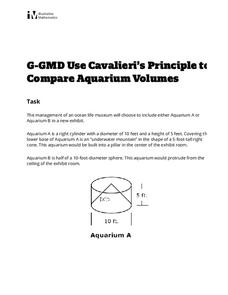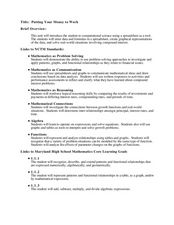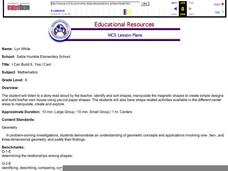Curated OER
Comparisons
In this thinking logically while counting objects worksheet, students observe a building covered with squares, stars, and beetles and fill in the blank spaces of a graph by comparing the objects. Students solve three problems.
Curated OER
Rooster's Off To See the World Number-Sense
Students recognize how numbers are used in number stories. For this Rooster's Off To See the World lesson, students participate in the story. Students complete a number activity and work on the computer to illustrate a number story. ...
Curated OER
Life is Full of Problems
Pupils use the problem solving strategy of guess and check to investigate math word problems. They determine which problem solving strategy or strategies would work best in problem situations.
Curated OER
Leaf Patterns
First graders explore the existence of patterns in everyday items. In this science and math integrated lesson, 1st graders match leaves with a name word card and organize them into four patterns. This lesson includes a reading of And the...
EngageNY
Patterns in Scatter Plots
Class members investigate relationships between two variables in the seventh installment of a 16-part module that teaches scholars how to find and describe patterns in scatter plots. Young mathematicians consider linear/nonlinear...
Curated OER
Solving a Simple Maze
It is a-maze-ing how lost one can get. Teams reconstruct a simple maze and solve it. Participants create an algorithm that a robot would follow in order to solve the maze as well. The activity includes an extension directing pupils to...
Curated OER
The Diagonal Of A Box
Students solve problems using the pythagorean theorem. They use critical thinking skills in order to use a systematic process to solve the problem. Upon solving each problem the uniqueness of the lesson is asking students to give an...
Curated OER
Checkers Anyone?
Students apply their knowledge of patterns and multiplication to count the number of 1x1, 2x2. and 3x3 squares on checkerboards of given dimensions. Students use patterns to complete a chart that goes up to an 8x8 square board, and later...
Illustrative Mathematics
Use Cavalieri’s Principle to Compare Aquarium Volumes
Learners are designing a stunning new water feature for an aquarium, but they soon discover that more than just a pretty home for their fishy friends is required. From calculating the volume of a composite shape through the abstract...
Curated OER
Narrow It Down
Students participate in a logic activity in which they identify items. In this logic activity, students work in groups as they play a questioning game that is similar to "Twenty Questions." They ask questions and rule out items in a...
Curated OER
Putting Your Money to Work
Students create a collect data on expenses. In this algebra lesson plan, students create a spreadsheet to solve scientific equations. They incorporate math, science and technology in this lesson plan.
Curated OER
The Circle's Measure
Students explore circumference and diameter. For this math lesson, students apply their knowledge of circumference and diameter to solve mathematical riddles. Students apply this knowledge to find circumference and diameter of various...
Curated OER
Begin with Buttons
Students utilize buttons to explore logical and numerical relationships. They focus on the two basic logical thinking skills, classification and seriation. Each student applies these developing skills to the operations of addition and...
Curated OER
Addition and Subtraction, Multiplication and Division
Students must use their mathematical reasoning skills in order to make four math statements true by filling in the boxes with the correct digits. Addition, subtraction, multiplication, and division problems appear.
Curated OER
Addition and Subtraction, Multiplication and Division Review
Students must use their mathematical reasoning skills in order to make four math statements true by filling in the boxes with the correct digits. Addition, subtraction, multiplication, and division problems appear.
Curated OER
Year 6 Booster pg 4
Students must use their mathematical reasoning skills in order to make four math statements true by filling in the boxes with the correct digits. Addition, subtraction, multiplication, and algebra problems are solved.
Curated OER
Counting Exercise
In this counting objects worksheet, 1st graders use logical thinking to count the various objects in the house. Students write the number count in the chart.
Curated OER
Great Lakes Homepage for Kids
Here are some outstanding lessons on the geology and history of the Great Lakes. These lessons are divided into Grade 4 -6, and Grade 7 - 8 activities. The activities all use the background information, maps, graphs, data, and Great...
Curated OER
Challenge Your Middle Schoolers with Mathematical Strategy Games!
Help learners develop the ability to think logically and mathematically, in a really fun and engaging way.
Radford University
Parallel Lines, Transversals, and Angles: What’s the Connection?
Streets, bridges, and intersections, oh my! Parallel lines and transversals are a present in the world around us. Learners begin by discovering the relationship of the angles formed by parallel lines and a transversal. They then apply...
Curated OER
I Can Build It.....Yes I Can!
Kindergartners listen to a story read by their teacher, then use magnetic shape pieces to construct simple designes. They "build" their own house using pre-cut paper shapes. This age-appropriate lesson would be an excellent choice for...
Curated OER
Get in Shape with Geometry
Using geoboards, computer programs, and hands-on manipulative materials, elementary schoolers engage in a study of two and three-dimensional geometric shapes. This lesson is chock full of good teaching ideas on the subject, and the...
Curated OER
Does My hair Disrupt Your Learning?
Students use the internet to research ways to save and earn money. They interview bankers and financial counselors to discover different types of investments. Students create public service announcements to inform their classmates of...
Curated OER
Exploration of "Pillbugs"
Fifth graders define vocabulary terms, identify the characteristics of a pillbug, and create a dichotomous key. Then they examine the pillbugs and make observations and record these observations. Finally, 5th graders observe specific...

























